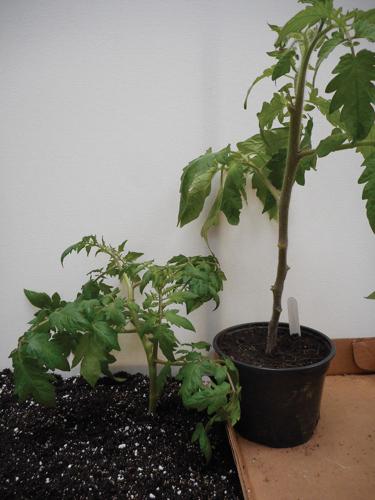Nothing compares to plucking a ripe tomato off the vine and indulging in its sweet taste.
The good news is, whether you have the space for a large garden or are limited to containers on a sunny porch, you can grow your own tomatoes.
The choices can seem overwhelming. Colors range from nearly white to almost black, or red, yellow, green and even stripes.
There are bite-sized cherry and extra-large beefsteak tomatoes, vining plants that grow 8 feet tall and produce tomatoes through the fall, and bush types that are suitable for smaller spaces or container growing. Some varieties even tumble over the edge of a hanging basket as they grow.
Although too late for this growing season, with a bit of planning you can grow your own tomato plants from seed. By doing so, you’ll have an expanded choice of varieties, though you’ll need to set aside an area in your home that provides enough warmth and light and sow the seeds six to eight weeks prior to the last anticipated frost. A heat mat is helpful for germination and a grow light will help to produce strong seedlings.
Easier, especially if you prefer a variety of tomatoes to many of the same type, is to buy plants. This time of year, garden centers and nurseries are filled with a wide selection to choose from, including many that have been developed for disease resistance. Select full, compact plants rather than tall, sparse specimens.
Whatever variety you choose, a little planning will put you on the path to a bountiful harvest.
First and foremost, tomatoes require sun, a lot of it, at least six to eight hours a day. They prefer loamy, well-drained, slightly acidic soil.
It’s a good idea to have a soil test done to determine specific soil amendment and fertilizer needs. The University of Vermont Agricultural and Environmental Testing Laboratory offers soil tests for home gardens. Instructions on how to collect and submit a sample can be found at pss.uvm.edu/ag_testing.
Once the soil warms and danger of frost has passed, take time to harden off your young tomato plants. While they love the sun, too much sun, too soon can be damaging. Gradually acclimate them to outdoor conditions by beginning with an hour or two outside in indirect sunlight, increasing exposure to sun daily for about a week.
Sometimes tomato plants grown indoors become “leggy” while reaching for more light. Luckily, there’s an easy fix for spindly plants. When preparing to plant, remove the bottom leaves and dig the planting hole deep enough to bury the plant with only the top several leaves above the surface (bare stem below).
Alternately, dig a trench and place the plant on its side, carefully bending the tip so that the remaining leaves on the stem are above the surface and cover the bare stem with a few inches of soil. The tomato will develop new roots along the stem where it’s been buried.
When planting, allow at least 2 feet between plants or as recommended for the particular type of tomato. Avoid crowding, which can make your tomato plants more susceptible to disease.
Be sure to add a support system at the time of planting, and water well, including a fertilizer recommended for tomatoes, according to package directions. Applying mulch can help the soil retain moisture.
As the season progresses, continue to water deeply as needed to maintain consistent moisture in the soil. Once fruit begins to form, fertilize again and every four to six weeks after that.
If you’re using containers, the process is much the same, with a few differences. Plant only one tomato plant per 4- to 5-gallon pot. Be sure to use a potting mix rather than garden soil, and water more frequently since containers will tend to dry out faster than your garden.
Soon you’ll be enjoying your very own home-grown tomatoes.
Talking tomatoes
Here are some terms you’re likely to encounter when deciding which tomato varieties to grow in your garden.
Determinate — compact plants (aka bush tomato), 1 to 4 feet tall; fruit ripens within a limited time period; requires support such as a traditional wire tomato cage.
Indeterminate — larger plants, tend to be vining; continue to grow and produce fruit throughout the season; require sturdier and taller support.
Hybrid tomato — a cross between different varieties.
Heirloom tomato — open-pollinated, non-hybrid, older varieties.
Open pollinated — Seeds will produce true to the parent plant.
Deborah J. Benoit is a University of Vermont Extension Master Gardener from North Adams, Mass., who is part of the Bennington County Chapter.
























(0) comments
Welcome to the discussion.
Log In
Keep it clean. Please avoid obscene, vulgar, lewd, racist or sexual language.
PLEASE TURN OFF YOUR CAPS LOCK.
Don't threaten. Threats of harming another person will not be tolerated.
Be truthful. Don't knowingly lie about anyone or anything.
Be nice. No racism, sexism or any sort of -ism that is degrading to another person.
Be proactive. Use the "Report" link on each comment to let us know of abusive posts.
Share with us. We'd love to hear eyewitness accounts, the history behind an article.